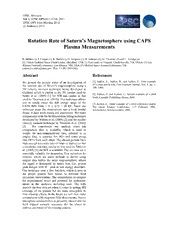
NASA Technical Reports Server (NTRS) 20110022475: Rotation Rate of Saturn's Magnetosphere using CAPS Plasma Measurements PDF
Preview NASA Technical Reports Server (NTRS) 20110022475: Rotation Rate of Saturn's Magnetosphere using CAPS Plasma Measurements
EPSCAbstracts Vol.6,EPSC-DPS2011-1748,2011 EPSC-DPSJointMeeting2011 (cid:13)c Author(s)2011 Rotation Rate of Saturn’s Magnetosphere using CAPS Plasma Measurements E. Sittler (1), J. Cooper (1), R. Hartle (1), D. Simpson (1), R. Johnson (2), M. Thomsen (3) and C. Arridge (4) (1) NASA Goddard Space Flight Center, Maryland, USA, (2) University of Virginia, Charlottesville, VA, USAA, (3) Los Alamos National Laboratory, Los Alamos, NM, USA, (4) Mullard Space Science Laboratory, UK, ([email protected] / Fax: +1-301-2861648) Abstract References We present the present status of an investigation of [1] Author, A., Author, B., and Author, C.: First example of a cited article title, First Example Journal, Vol. 1, pp. 1- the rotation rate of Saturn’s magnetosphere using a 100, 1999. 3D velocity moment technique being developed at Goddard which is similar to the 2D version used by [2] Author, D. and Author, E.: Second example of a cited Sittler et al. (2005) [1] for SOI and similar to that book, Example Publishing House, 2000. used by Thomsen et al. (2010). This technique allows one to nearly cover the full energy range of the [3] Author, F.: Third example of a cited conference paper, CAPS IMS from 1 V ≤ E/Q < 50 kV. Since our The Great Science Conference, 1–7 February 2001, technique maps the observations into a local inertial Sciencetown, Sciencecountry, 2001. frame, it does work during roll maneuvers. We make comparisons with the bi-Maxwellian fitting technique developed by Wilson et al. (2008) [2] and the similar velocity moment technique by Thomsen et al. (2010) [3]. We concentrate our analysis when ion composition data is available, which is used to weight the non-compositional data, referred to as singles data, to separate H+, H2+ and water group ions (W+) from each other. The chosen periods have high enough telemetry rates (4 kbps or higher) so that coincidence ion data, similar to that used by Sittler et al. (2005) [1] for SOI is available. The ion data set is especially valuable for measuring flow velocities for protons, which are more difficult to derive using singles data within the inner magnetosphere, where the signal is dominated by heavy ions (i.e., proton peak merges with W+ peak as low energy shoulder). Our technique uses a flux function, which is zero in the proper plasma flow frame, to estimate fluid parameter uncertainties. The comparisons investigate the experimental errors and potential for systematic errors in the analyses, including ours. The rolls provide the best data set when it comes to getting 4PI coverage of the plasma but are more susceptible to time aliasing effects. In the future we will then make comparisons with magnetic field observations, Saturn ionosphere conductivities as presently known and the field aligned currents necessary for the planet to enforce corotation of the rotating plasma.
